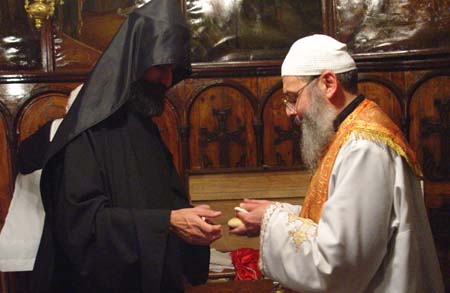







May 5, 2006 - Post No. 73
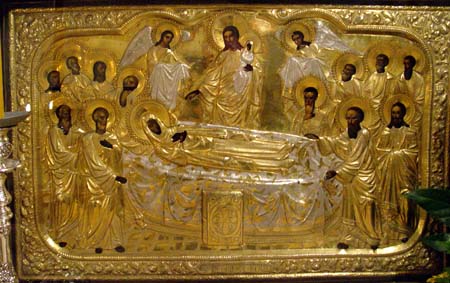
This morning Fr. Emmanuel knocks at my door a little after 8 a.m., and it is time to go for the Badarak (celebration of the Armenian Divine Liturgy) at the Tomb of the Blessed Virgin in the Valley of Jehoshaphat, at the foot of the Mount of Olives. (For more information on the Tomb, see my earlier post "Armenian Feast of the Annunciation.")
Yesterday, Fr. Emmanuel suggested that I accompany him today, and I am pleased to have this opportunity for what I expect will be a quiet and inspiring celebration at the Tomb of St. Mary the Virgin.

Armenian prayers of preparation.
On our arrival at the tomb, I discover that things may not be as quiet as I imagined. It seems that the Copts will be celebrating the Divine Liturgy at the same time as the Armenian Badarak. This simultaneous celebration is quite deliberate, part of the formal arrangement known here as the status quo -- the long since negotiated settlement for the way things are done at the holy places in Jerusalem.

Coptic preparation of the Eucharistic gifts.
The status quo was formalised in 1852, and it is reflected in the triumvirate that governs the Holy Sepulchre. It is intended to keep the peace and protect the interests of the primary stake holders in the Christian community.
Under the status quo at the Virgin's Tomb, there can only be two scheduled blocks of time for the daily celebration of the Divine Liturgy, one for the Greeks and one for the Armenians. To add a third block to accommodate another tradition, the Copts for instance, would be considered a violation of the status quo.
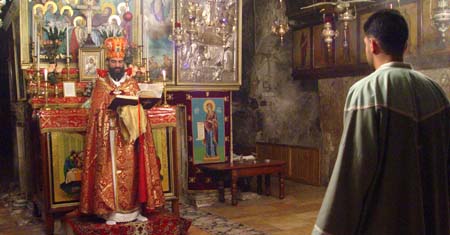
Armenian proclamation of the Holy Gospel.
Therefore, the only way the liturgies of the other orthodox traditions (Russians, Rumanians, Copts, Syrians ...) can take place at the Virgin's Tomb is by piggy backing, or the celebration of a liturgy simultaneously with one of the status quo stake holders. The Russians and Rumanians would join the Greeks for their celebrations of the liturgy; and the Copts and Syrians join the Armenians.
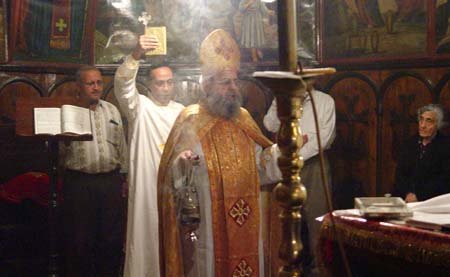
Coptic affirmation of faith with the Creed.
So it is that Wednesday and Friday mornings, every week, year round, the Copts celebrate the Divine Liturgy at the Tomb of Mary the Virgin, in the time slot reserved for the Armenian Badarak; and on Wednesday mornings, things get really interesting when the Syrians join in to make a trio of simultaneous celebrations, each with its own language, music, and liturgical gesture.
These celebrations take place in a single room with several altars. The space is not all that large really, and the blend of sights and sounds during this morning's simultaneous liturgies is "interesting" ... to say the least.
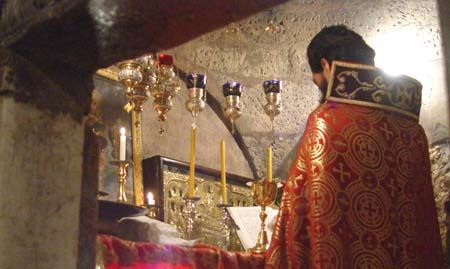
Armenian prayers after the consecration of the bread
and wine.
When we arrive at the Virgin's Tomb this morning, the Copts are robed and waiting at the altar reserved for their use. To avoid evoking the ire of the Greek community -- and there are a couple Greek monks around keeping an eye on things -- the Copts must wait for the Armenian Badarak to formally begin before launching into their own liturgy. From then on, the two liturgies keep pace, using pretty much same framework, but the Coptic liturgy must conclude either at the same time or slightly before the final notes of the Armenian Badarak.
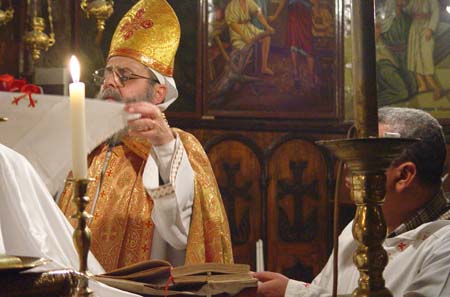
Conclusion of the Coptic Great Entrance (Offertory).
Click here for a video (26MB) from this morning's simultaneous celebration of the Divine Liturgy. It gives you an idea of the combined result. The movie was filmed during the censing, at the opening of the Armenian and Coptic liturgies -- note how the Armenian celebrant, Fr. Emmanuel pays a call on the Copts during his turn at censing.
As if the simultaneous celebrations didn't confuse things enough, several tourist groups come and go during the liturgies as well.
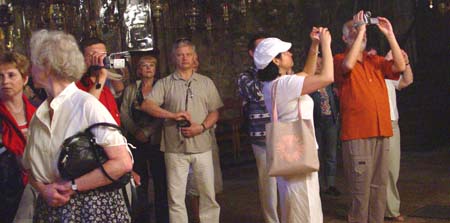
In the picture above, the Coptic celebration is going on behind the group of tourists, and the Armenian in front. The Copts and Armenians seem very relaxed about all of this, clearly leaving room for the come and go of pilgrims is also part of at least the informal status quo.
Sometimes this does get a bit strange, however. For instance the gentleman pictured below (centre right) decides to take a short cut straight across the Armenian sanctuary, right in the middle of the Badarak, to get to the door of small inner shrine (lower right corner), the actual site of the Virgin's Tomb, even though it is still being used for the Armenian liturgy.
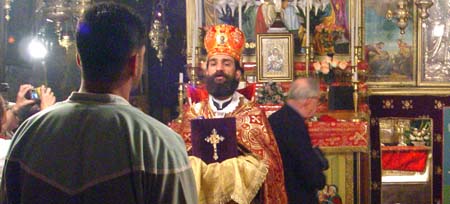
Yet, despite the seeming confusion this morning, there is something remarkable about the Virgin's Tomb and the liturgies taking place here today. Fr. Emmanuel kindly invites me to join him in the inner shrine, to stand beside him at the altar erected over the stone slab where the body of Mary is believed to have been laid. Here, thanks in part to the muffling effect of the thick stone walls of the tiny shrine, all is calm, all is bright.
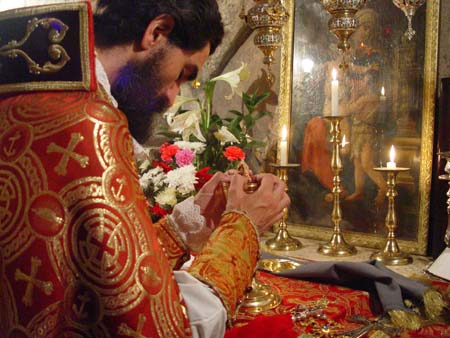
Following the Badarak, Fr. Emmanuel joins his Coptic counterpart for an exchange of Eucharistic breads left unused in the simultaneous liturgies this morning. The two are good friends, and this is not the first time they have celebrated the Divine Liturgy at either end of the Armenian chapel at the Tomb of the Virgin Mary, nor is it likely to be the last.
